1、创建商品分类分支goods_cate并push到远程
查看分支:
git branch
创建分支:
git checkout -b goods_cate
推送到远程:(以前码云中没有该分支,所以要加-u,如果码云中有该分支,则不需要加-u)
git push -u origin goods_cate
2、通过路由加载商品分类组件
新建goods文件夹和Cate.vue文件:
<template> <div> <h3>商品分类组件</h3> </div> </template> <script> export default { } </script> <style lang="less" scoped> </style>
添加路由:
import Cate from '../components/goods/Cate.vue' const routes = [ { path: '/', redirect: '/login' }, // 重定向 { path: '/login', component: Login }, { path: '/home', component: Home, redirect: '/welcome', // 重定向 children: [ // 子路由 { path: '/welcome', component: Welcome }, { path: '/users', component: Users }, // 用户列表 { path: '/rights', component: Rights }, // 权限列表 { path: '/roles', component: Roles }, // 角色列表 { path: '/categories', component: Cate } // 商品分类 ] } ]
点击左侧菜单的商品分类的效果如图:
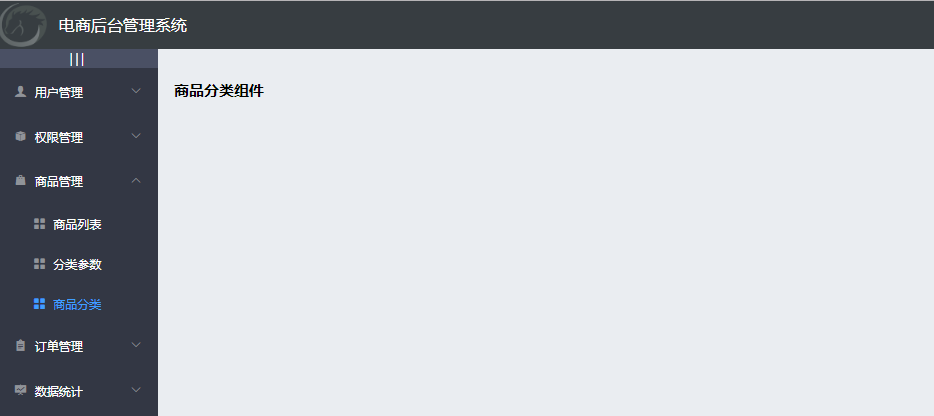
3、绘制商品分类组件的基本布局
还是面包屑和card视图:
<template> <div> <!--面包屑导航区域--> <el-breadcrumb separator-class="el-icon-arrow-right"> <el-breadcrumb-item :to="{ path: '/home' }">首页</el-breadcrumb-item> <el-breadcrumb-item>商品管理</el-breadcrumb-item> <el-breadcrumb-item>商品分类</el-breadcrumb-item> </el-breadcrumb> <!--卡片视图区域--> <el-card> <!--添加角色按钮区域--> <el-row> <el-col> <el-button type="primary">添加分类</el-button> </el-col> </el-row> <!--分类列表区域--> <!--分页区域--> </el-card> </div> </template> <script> export default { } </script> <style lang="less" scoped> </style>
4、调用api接口获取商品分类列表数据
请求参数
type [1,2,3] 值:1,2,3 分别表示显示一层二层三层分类列表 【可选参数】如果不传递,则默认获取所有级别的分类
pagenum 当前页码值 【可选参数】如果不传递,则默认获取所有分类
pagesize 每页显示多少条数据 【可选参数】如果不传递,则默认获取所有分类
<script> export default { data() { return { // 查询条件 queryInfo: { type: 3, pagenum: 1, pagesize: 5 }, cateList: [], // 商品分类列表数据 total: 0 // 总数据条数 } }, created() { this.getCateList() }, methods: { // 获取商品分类数据 async getCateList() { const { data: res } = await this.$http.get('categories', { params: this.queryInfo }) if (res.meta.status !== 200) { return this.$message.error('获取商品分类失败') } console.log(res.data) this.cateList = res.data.result // 带参数请求,返回的数据多一层result,还有总数total,当前页pagenum,当然页条数pagesize this.total = res.data.total } } } </script>
注意:这里请求接口时记得带参数,否则会返回一个总数据的data,而没有total、pagenum,pagesize参数。
5、使用vue-table-with-tree-grid树形表格组件
element没有相应的组件,要通过第三方插件来实现
打开vue ui面板,找到依赖项,点击安装依赖,在弹出的对话框中,搜索:vue-table-with-tree-grid,进行安装。
然后查看文档,有两种用法:
import Vue from 'vue' import ZkTable from 'vue-table-with-tree-grid' Vue.use(ZkTable) // 或者 import Vue from 'vue' import ZkTable from 'vue-table-with-tree-grid' Vue.component(ZkTable.name, ZkTable)
打开入口文件main.js,导入插件:
import TreeTable from 'vue-table-with-tree-grid'
Vue.component('tree-table', TreeTable)
参考官方文档给的示例代码,重新回到Cate.vue文件,使用插件:
<!--分类列表区域--> <tree-table :data="cateList" :columns="columns" :selection-type="false" :expand-type="false" show-index index-text="#" border :show-row-hover="false"></tree-table>
columns 表格各列的配置(具体见下文:Columns Configs)
selection-type 是否为多选类型表格
expand-type 是否为展开行类型表格(为 True 时,需要添加名称为 '$expand' 的作用域插槽, 它可以获取到 row, rowIndex)
show-index 是否显示数据索引
index-text 数据索引名称
border 是否显示纵向边框
show-row-hover 鼠标悬停时,是否高亮当前行
定义columns:
// 为table表格各列的配置定义 columns: [ { label: '分类名称', // 列标题名称 prop: 'cat_name' // 对应列内容的属性名 }, { label: '是否有效' }, { label: '排序' }, { label: '操作' } ]
此时效果图:
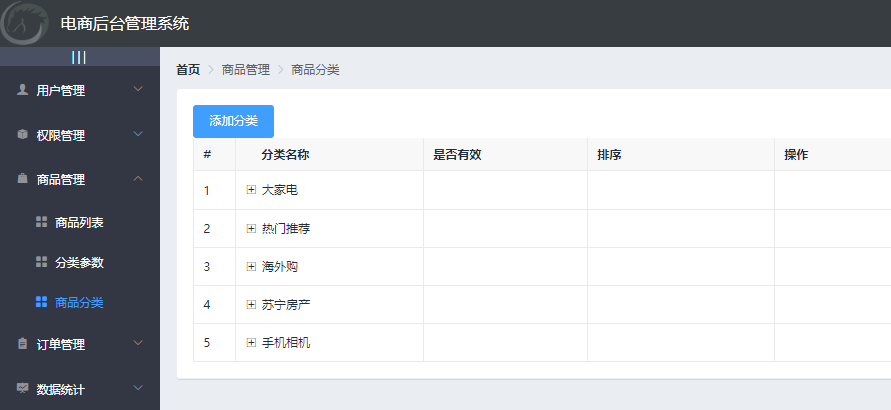
6、使用自定义模板渲染表格数据
先自定义是否有效模板:
// 为table表格各列的配置定义 columns: [ { label: '分类名称', // 列标题名称 prop: 'cat_name' // 对应列内容的属性名 }, { label: '是否有效', type: 'template', // 表示:把当前列定义为模板列 template: 'isok' // 表示当前这列使用的模板名称 }, { label: '排序' }, { label: '操作' } ]
添加到表格:
<!--分类列表区域--> <tree-table :data="cateList" :columns="columns" :selection-type="false" :expand-type="false" show-index index-text="#" border :show-row-hover="false"> <template slot="isok" scope="scope"> <i v-if="!scope.row.cat_deleted" class="el-icon-success"></i> <i v-else class="el-icon-error"></i> </template> </tree-table> <style lang="less" scoped> .el-icon-success{color: lightgreen;} .el-icon-error{color:red;} </style>
此时效果图:
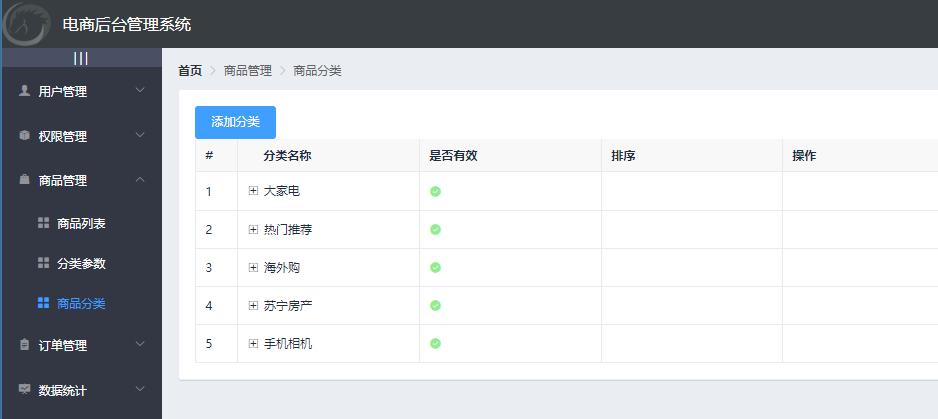
7、 渲染排序和操作对应的UI
columns:
// 为table表格各列的配置定义 columns: [ { label: '分类名称', // 列标题名称 prop: 'cat_name' // 对应列内容的属性名 }, { label: '是否有效', type: 'template', // 表示:把当前列定义为模板列 template: 'isok' // 表示当前这列使用的模板名称 }, { label: '排序', type: 'template', // 表示:把当前列定义为模板列 template: 'order' // 表示当前这列使用的模板名称 }, { label: '操作', type: 'template', // 表示:把当前列定义为模板列 template: 'operate' // 表示当前这列使用的模板名称 } ]
排序和操作列代码:
<!--排序的作用域插槽--> <template slot="order" scope="scope"> <el-tag v-if="scope.row.cat_level == 0">一级</el-tag> <el-tag v-else-if="scope.row.cat_level == 1" type="success">二级</el-tag> <el-tag v-else type="warning">三级</el-tag> </template> <!--操作的作用域插槽--> <template slot="operate" scope="scope"> <el-button size="mini" type="primary" icon="el-icon-edit">编辑</el-button> <el-button size="mini" type="danger" icon="el-icon-delete">删除</el-button> </template>
此时效果图:
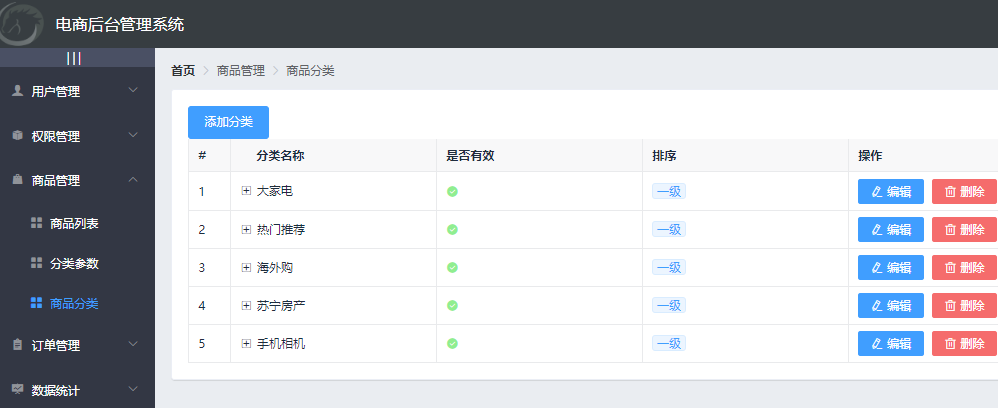
8、实现分页功能
添加分页代码:
<!--分页区域--> <el-pagination @size-change="handleSizeChange" @current-change="handleCurrentChange" :current-page="queryInfo.pagenum" :page-sizes="[3, 5, 10, 15]" :page-size="queryInfo.pagesize" layout="total, sizes, prev, pager, next, jumper" :total="total" ></el-pagination>
添加handleSizeChange和handleCurrentChange:
// 监听 pagesize 改变 handleSizeChange(newSize) { this.queryInfo.pagesize = newSize this.getCateList() }, // 监听pagenum 改变 handleCurrentChange(newPage) { this.queryInfo.pagenum = newPage this.getCateList() }
给添加分类按钮和表格之间添加间距:
<!--分类列表区域--> <tree-table class="treeTable" :data="cateList" :columns="columns" :selection-type="false" :expand-type="false" show-index index-text="#" border :show-row-hover="false"> <style lang="less" scoped> .el-icon-success{color: lightgreen;} .el-icon-error{color:red;} .treeTable{margin-top:15px;} </style>
此时效果图:
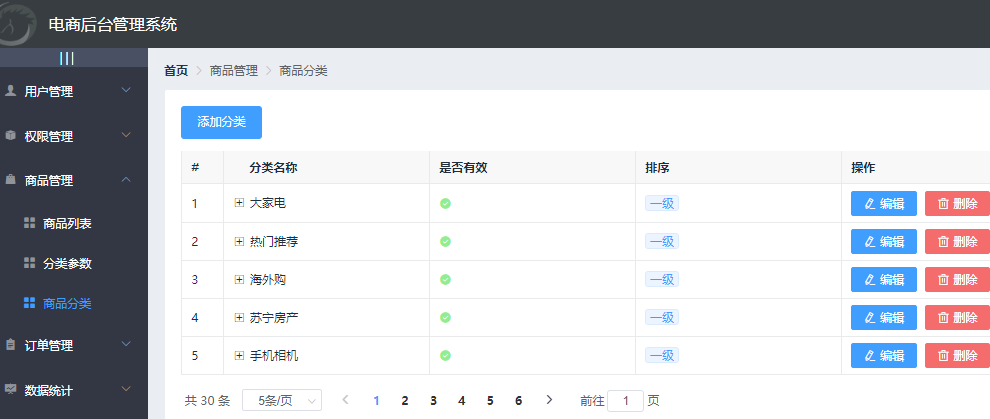
9、添加分类的对话框和表单
添加分类按钮添加点击事件:
<!--添加分类按钮区域--> <el-row> <el-col> <el-button type="primary" @click="showAddCateDialog">添加分类</el-button> </el-col> </el-row> <script> export default { 。。。 methods: { // 点击按钮 弹出添加分类对话框 showAddCateDialog() { this.addCateDialogVisible = true } } } </script>
添加对话框代码:
<!--添加分类的对话框--> <el-dialog title="添加分类" :visible.sync="addCateDialogVisible" width="50%" > <!--添加分类表单区域--> <el-form :model="addCateForm" :rules="addCateFormRules" ref="addCateFormRef" label-width="90px"> <el-form-item label="分类名称" prop="cat_name"> <el-input v-model="addCateForm.cat_name"></el-input> </el-form-item> <el-form-item label="父级分类"> </el-form-item> </el-form> <!--底部按钮区域--> <span slot="footer" class="dialog-footer"> <el-button @click="addCateDialogVisible = false">取 消</el-button> <el-button type="primary" @click="addCateDialogVisible = false">确 定</el-button> </span> </el-dialog> <script> export default { data() { return { addCateDialogVisible: false, // 控制添加分类对话框是否显示 // 添加分类的表单数据对象 addCateForm: { cat_name: '', // 将要添加的分类名称 cat_pid: 0, // 父分类的ID cat_level: 0 // 要添加分类的等级,默认要添加的是一级分类 }, // 添加分类表单的验证规则对象 addCateFormRules: { cat_name: [ { required: true, message: '请输入分类名称', trigger: 'blur' } ] } } } } </script>
此时效果图:
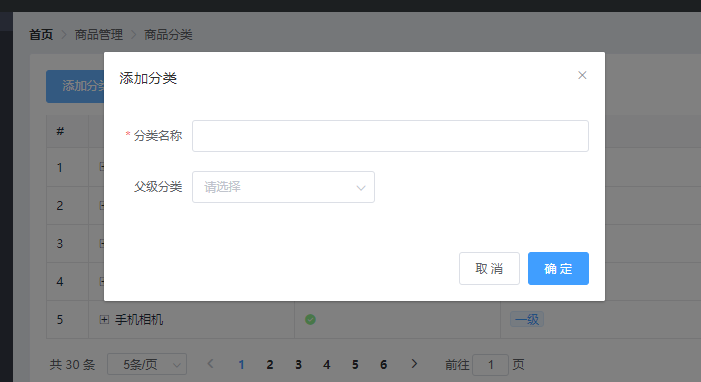
10、获取父级分类的数据列表
添加代码获取父级分类数据:
parentCateList: [] // 父级分类列表数据 // 点击按钮 弹出添加分类对话框 showAddCateDialog() { // 获取父级分类的数据列表 this.getParentCateList() this.addCateDialogVisible = true }, // 获取父级分类的数据列表 async getParentCateList() { const { data: res } = await this.$http.get('categories', { params: { type: 2 } }) console.log(res) if (res.meta.status !== 200) { return this.$message.error('获取父级分类数据失败') } this.parentCateList = res.data }
11、通过级联选择器渲染数据
Cascader 级联选择器
当一个数据集合有清晰的层级结构时,可通过级联选择器逐级查看并选择。
先导入到element.js里,这里就不写了。
value / v-model 选中项绑定值,数组
options 可选项数据源,键名可通过 Props 属性配置
props 配置选项,具体见下表
clearable 是否支持清空选项
expandTrigger 次级菜单的展开方式
checkStrictly 是否严格的遵守父子节点不互相关联
value 指定选项的值为选项对象的某个属性值
label 指定选项标签为选项对象的某个属性值
children 指定选项的子选项为选项对象的某个属性值
添加代码:
<el-form-item label="父级分类"> <!--级联选择器--> <!-- options用来指定数据源 props用来指定配置对象--> <el-cascader v-model="selectedKeys" :options="parentCateList" :props="cascaderProps" @change="parentCateChanged" clearable></el-cascader> </el-form-item> <script> export default { data() { return { parentCateList: [], // 父级分类列表数据 // 指定级联选择器的配置对象 cascaderProps: { expandTrigger: 'hover', // 次级菜单的展开方式 click / hover checkStrictly: true, // 允许选择任意一级的选项 value: 'cat_id', // 指定选中值的属性 label: 'cat_name', // 指定选中标签的名称 children: 'children' // 指定父子嵌套的属性 }, // 选中的父级分类的ID数组 selectedKeys: [] } }, methods: { // 选择项发生变化时触发这个函数 parentCateChanged() { console.log(this.selectedKeys) } } } </script> <style lang="less" scoped> .el-cascader{width: 100%;} </style>
还要记得在全局样式global.css里添加:
.el-cascader-panel{height:200px;}
否则选项框会超长。
注意:是否允许选择任意一级的选项(例如只选第一级),以前版本的element是添加change-on-select,新版本是在props里添加checkStrictly: 'true'。
此时效果图:

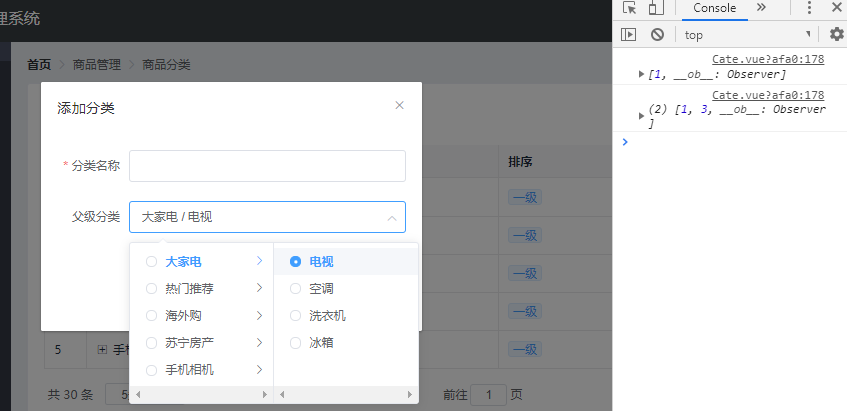
新版bug问题
- 点击圆圈后理想是自动收起下拉,但是他这个也没有
- 而且只能点击圆圈才能选中,点击文字 label 没有效果
去百度找了一些资料,终于解决了这两个问题:
<el-cascader v-model="selectedKeys" :options="parentCateList" :props="cascaderProps" @change="parentCateChanged" clearable ref="cascaderRef" @expand-change="cascaderClick" @visible-change="cascaderClick"></el-cascader>
cascadderClick函数:
// 解决bug:点击圆圈后是自动收起下拉;点击文字label同样实现效果 cascaderClick() { let that = this setTimeout(function() { document.querySelectorAll('.el-cascader-node__label').forEach(el => { el.onclick = function() { this.previousElementSibling.click() that.$refs.cascaderRef.dropDownVisible = false } }) document .querySelectorAll('.el-cascader-panel .el-radio') .forEach(el => { el.onclick = function() { that.$refs.cascaderRef.dropDownVisible = false } }) }, 100) }
OK,现在可以完美实现效果。
12、根据父分类的变化处理表单中的数据
// 添加分类的表单数据对象 addCateForm: { cat_name: '', // 将要添加的分类名称 cat_pid: 0, // 父分类的ID cat_level: 0 // 要添加分类的等级,默认要添加的是一级分类 },
根据刚才建立的表单数据对象分析:如果在表单中只添加分类名称 ,那么父分类id是0,当前要添加分类的等级是0,默认添加的是一级分类;如果选中了一级分类,那么父分类id就是选中的分类id值,当前要添加分类的等级是1,添加的是二级分类;如果选中了一级和二级分类,那么父分类id就是选中的数组中二级分类id的值,当前要添加的分类的等级是2,添加的是三级分类。说的有点绕,具体看代码吧。。
// 选择项发生变化时触发这个函数 parentCateChanged() { console.log(this.selectedKeys) // 如果 selectedKeys 数据中的 length 大于0,则证明选中了父级分类 // 反之,就说明没有选中任何父级分类 if (this.selectedKeys.length > 0) { // 选择最后一项当作父分类ID赋值 this.addCateForm.cat_pid = this.selectedKeys[this.selectedKeys.length - 1] // 为当前要添加的分类的等级赋值 this.addCateForm.cat_level = this.selectedKeys.length return } else { // 父分类ID赋值 this.addCateForm.cat_pid = 0 // 为当前要添加的分类的等级赋值 this.addCateForm.cat_level = 0 } console.log(this.addCateForm) }
此时三种情况的打印结果分别为:
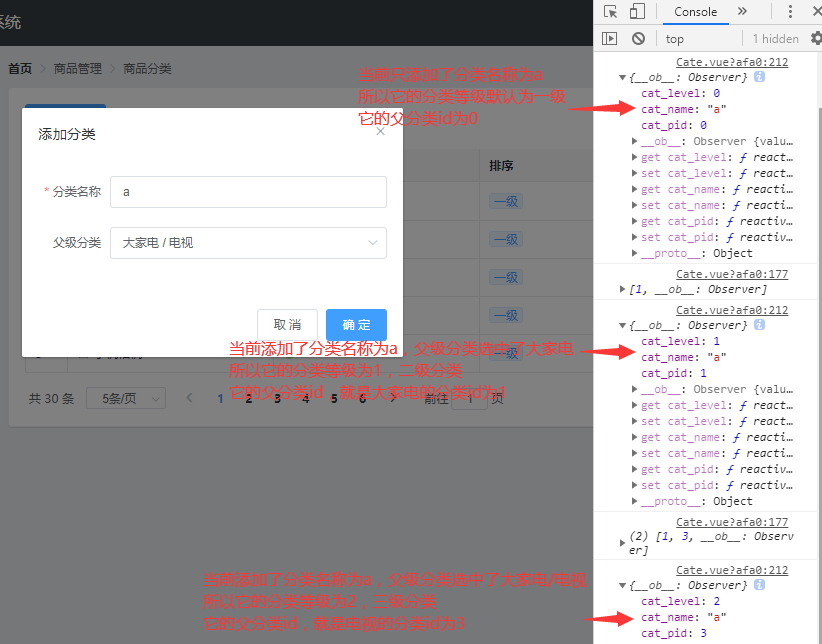
13、在对话框添加close事件,重置表单数据
给对话框添加colse关闭事件:
<!--添加分类的对话框--> <el-dialog title="添加分类" :visible.sync="addCateDialogVisible" width="50%" @close="addCateDialogClosed">
// 监听 添加分类对话框的关闭事件 addCateDialogClosed() { // 表单内容重置为空 this.$refs.addCateFormRef.resetFields() // 通过ref引用调用resetFields方法 // 选中的父级分类的ID数组 重置为空 this.selectedKeys = [] // 父分类id 和 当前分类等级 重置为空 this.addCateForm.cat_pid = 0 this.addCateForm.cat_level = 0 }
14、完成添加分类的操作
调用api的添加分类接口,请求路径:categories,请求方法:post,
请求参数
cat_pid 分类父 ID 不能为空,如果要添加1级分类,则父分类Id应该设置为 `0`
cat_name 分类名称 不能为空
cat_level 分类层级 不能为空,`0`表示一级分类;`1`表示二级分类;`2`表示三级分类
继续完善addCate函数:请求参数前面已经定义过了addCateForm
// 点击按钮,添加新的分类 addCate() { // console.log(this.addCateForm) this.$refs.addCateFormRef.validate(async valid => { if (!valid) return // 可以发起添加分类的网络请求 const { data: res } = await this.$http.post('categories', this.addCateForm) if (res.meta.status !== 201) { this.$message.error('添加商品分类失败!') } this.$message.success('添加商品分类成功!') this.getCateList() this.addCateDialogVisible = false }) }
此时效果图:
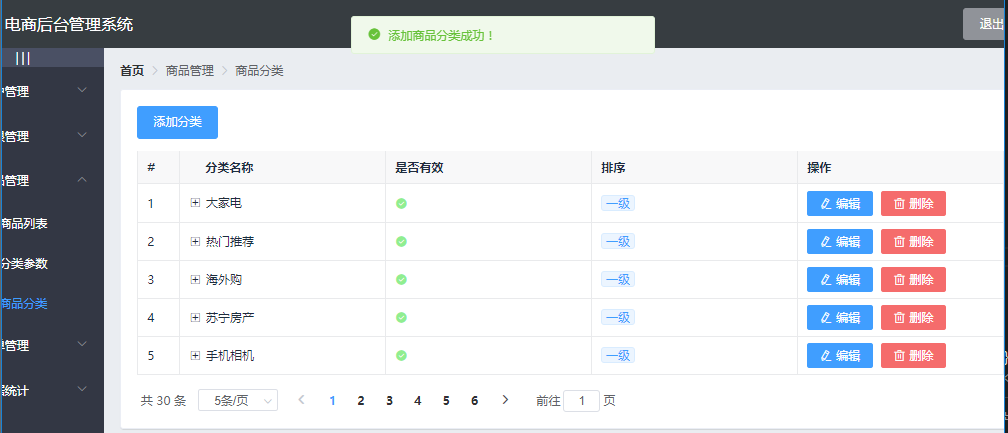
15、实现编辑分类功能操作
先给编辑按钮添加点击事件:
<el-button size="mini" type="primary" icon="el-icon-edit" @click="editCateDialog(scope.row.cat_id)">编辑</el-button>
添加编辑对话框代码:
打开对话框是请求根据 id 查询分类的接口,请求路径:categories/:id,请求方法:get
然后把查询到的数据赋值给编辑分类的表单数据
<!--编辑商品分类的对话框--> <el-dialog title="编辑分类信息" :visible.sync="editDialogVisible" width="50%" @close="editDialogClosed" > <!--内容主体区域--> <el-form :model="editForm" :rules="addCateFormRules" ref="editFormRef" label-width="90px"> <el-form-item label="分类名称" prop="cat_name"> <el-input v-model="editForm.cat_name"></el-input> </el-form-item> </el-form> <!--底部按钮区域--> <span slot="footer" class="dialog-footer"> <el-button @click="editDialogVisible = false">取 消</el-button> <el-button type="primary" @click="editCateInfo">确 定</el-button> </span> </el-dialog> <script> export default { data() { return { editDialogVisible: false, // 控制编辑分类的对话框是否显示 // 编辑分类信息的表单数据 editForm: { cat_name: '' } } }, methods: { // 监听 编辑分类对话框 async editCateDialog(id) { // 发起根据 id 查询分类的网络请求 const { data: res } = await this.$http.get('categories/' + id) if (res.meta.status !== 200) { this.$message.error('查询分类信息失败') } this.editForm = res.data this.editDialogVisible = true }, // 监听 编辑分类信息对话框的关闭事件 editDialogClosed() { // 表单内容重置为空 this.$refs.editFormRef.resetFields() // 通过ref引用调用resetFields方法 } } } </script>
添加确定按钮绑定点击事件,完成用户信息的修改:
先预校验,然后调用api的编辑提交分类接口,请求路径:categories/:id,请求方法:put,请求参数:cat_name 分类名称 不能为空
// 点击按钮 修改角色信息 editRoleInfo() { this.$refs.editFormRef.validate(async valid => { if (!valid) return // 可以发起修改用户信息的网络请求 const { data: res } = await this.$http.put('categories/' + this.editForm.cat_id, { cat_name: this.editForm.cat_name }) if (res.meta.status !== 200) { return this.$message.error('编辑商品分类失败!') } this.$message.success('编辑商品分类成功!') this.getCateList() this.editDialogVisible = false }) }
ok,测试已经可以编辑分类名称:

16、实现删除分类功能操作
给删除按钮添加点击事件:根据id
<el-button size="mini" type="danger" icon="el-icon-delete" @click="delCateDialog(scope.row.cat_id)">删除</el-button>
根据分类id,调用api的删除分类接口,请求路径:categories/:id,请求方法:delete
// 监听 删除分类对话框 async delCateDialog(id) { console.log(id) // 弹框 询问用户是否删除 const confirmResult = await this.$confirm('此操作将永久删除该分类, 是否继续?', '提示', { confirmButtonText: '确定', cancelButtonText: '取消', type: 'warning' }).catch(err => err) // 如果用户确认删除,则返回值为字符串 confirm // 如果用户取消删除,则返回值为字符串 cancel // console.log(confirmResult) if (confirmResult !== 'confirm') { return this.$message.info('已取消删除') } // console.log('确认删除') const { data: res } = await this.$http.delete('categories/' + id) if (res.meta.status !== 200) { return this.$message.error('删除分类失败!') } this.$message.success('删除分类成功!') this.getCateList() }
完成效果图:

17、将goods_cate提交到远程仓库
先查看分支:
git branch
查看当前文件状态:
git status
然后提交到暂存区:
git add .
把当前提交到goods_cate分支:
git commit -m "完成了商品分类功能的开发"
推送到云端goods_cate分支:
git push
把goods_cate分支合并到master:
git checkout master
git merge goods_cate
git push
ok,完成!